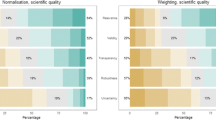Abstract
This article discusses to which extent the forthcoming ISO standard on life cycle impact assessment (ISO/DIS 14042) will be able to accommodate current best available practice in this field. There is, particularly, the risk that the requirement of scientific validity for public comparative assertions cannot be met sufficiently so that the standard may become counterproductive. It is concluded that current best practice for most of the impact categories is compatible with the forthcoming standard. However, difficulties will arise with the toxicity categories, in particular with human toxicity. There is no encompassing indicator is available which does not involve weighting between subcategories. A major improvement would be if, for weighting within categories, internationally accepted value choices would be established as a sufficient condition for public comparative assertions.
Similar content being viewed by others
References
Aldenberg, T. andSlob, W. (1991): Confidence limits for hazardous concentrations based on logistically distributed NOEC toxicity data. RIVM report no. 719102002
Burke, T.A.;Doull, J.;McKone, T.E.;Paustenbach, D.J.;Scheuplein, R.; Udode Haes,H.A. andYoung, J.L. (1995): Human health assessment and life-cycle assessment: analysis by an expert panel. ILSI, Washington DC
Carter, W. (1994): Development of ozone reactivity scales for volatile organic compounds. Journal of the Air and Waste Management Association 44: 881–889
Consoli, F.;Allen, D.;Boustead, I.;Fava, J.;Franklin, W.;Jensen, A.A.;de Oude, N.;Parrlsh, R.;Perriman, R.;Postlethwaite, D.;Quay, B.;Seguin, J. andVigon, B. (1993): Guidelines for Life-Cycle Assessment: a ‘Code of Practice’. SETAC, Brussels, Pensacola
Derwent, R.G.;Jenkin, M.E.;Saunders, S.M. andPiling, M.J. (1998): Photochemical ozone creation potentials for organic compounds in Northwest Europe calculated with a master chemical mechanism. Atmospheric Environment 32: 2429–2441
Emans, H.J.B.;van de Plassche, E.J.;Canton, H.J.;Okkerman, P.C. andSparenburg, P.M. (1993): Validation of some extrapolation methods used for effect assessment. Environmental Toxicology and Chemistry 12: 2139–2154
Goedkoop, M.J.;Hoestetter, P.;Muller-Wenk, R. andSpriensma, R. (1998): The Eco-Indicator 98 Explained. Int. J. LCA 3 (6): 352–360
Hoestetter, P. (1998): Perspectives in life cycle impact assessment. A structured approach to combine models of the technosphere, ecosphere and valuesphere. Kluwer, Boston, Dordrecht, London
Huijbregts, M.A.J. (1999): Priority assessment of toxic substances in LCA; application of the uniform system for the evaluation of substances 2.0. Draft 1VAM report, University of Amsterdam; part of updated CML guide on LCA (in prep.)
International Organization for Standardization (1998): ISO/DIS 14042: Environmental management-Life cycle assessment-Life cycle impact assessment
Jolliet, O. andCrettaz, P. (1997): Calculation of fate and exposure coefficients for the life cycle toxicity assessment of air emissions. Int. J. LCA 2 (2): 104–110
Jolliet, O. andCrettaz, P. (1999): Modelling of exposure efficiency for the characterization of human toxicity in Life Cycle Assessment. Int. Journal of Risk Analysis, submitted
Klepper, O. and D. van de Meent, 1997: Mapping the potentially affected fraction (PAF) of species as an indicator of generic toxic stress. RIVM-report no. 607504001, Bilthoven (NL)
Lindeijer, E. (1998): Workshop report on land use impacts, including survey, 8th annual SETAC-Europe meeting, Bordeaux
Murray, Ch.J.L. andLopez, A.D. (Eds.), 1996: The Global Burden of Disease, Volume 1 of Global Burden of Disease and Injury Series, WHO / Harvad School of Public Health / World Bank, Harvard University Press, Boston
Notarnicola, B.;Huppes, G. andvan den Berg, N.W. (1998): Evaluating options in LCA: the emergence of conflicting paradigms for impact assessment and evaluation. Int. J. LCA 3(5): 289–300
Owens, J.W. (1998): Life Cycle Impact Assessment: the use of subjective judgements in classification and characterization. Int. J. LCA 3(1): 43–46
Potting, J.;Schöpp, W.;Blok, K. andHauschild, M. (1998): Site-dependent life-cycle impact assessment in acidification. Journal of Industrial Ecology 2 (2): 63–87
Udo de Haes, H.A.;Jolliet, O.;Finnveden, G.;Hauschild, M.;Krewitt, W. andMueller-Wenk, R. (1999): Best available practice regarding impact categories and category indicators in Life Cycle Impact Assessment. Report of second working group on life cycle impact assessment of SETAC-Europe. Brussels
Author information
Authors and Affiliations
Rights and permissions
About this article
Cite this article
de Haes, H.A.U., Jolliet, O. How does iso/dis 14042 on life cycle impact assessment accommodate current best available practice?. Int. J. LCA 4, 75–80 (1999). https://doi.org/10.1007/BF02979404
Received:
Accepted:
Issue Date:
DOI: https://doi.org/10.1007/BF02979404




